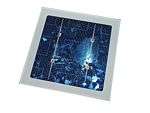Solar lamp

A solar lamp also known as solar light or solar lantern, is a lighting system composed of an LED lamp, solar panels, battery, charge controller and there may also be an inverter. The lamp operates on electricity from batteries, charged through the use of solar photovoltaic panel.
Solar-powered household lighting can replace other light sources like candles or kerosene lamps. Solar lamps have a lower operating cost than kerosene lamps because renewable energy from the sun is free, unlike fuel. In addition, solar lamps produce no indoor air pollution unlike kerosene lamps. However, solar lamps generally have a higher initial cost, and are weather dependent.
Solar lamps for use in rural situations often have the capability of providing a supply of electricity for other devices, such as for charging cell phones. American investors have been working towards developing a $10 / unit solar lantern for replacement of kerosene lamps.[1]
History
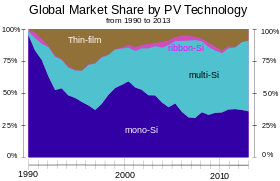
Some solar photovoltaics use Monocrystalline silicon or polycrystalline silicon panels, while newer technologies have used thin-film solar cells.[2] Since modern solar cells were introduced in 1954 at Bell labs,[3][4] advances in solar cell efficiency at converting light into electric power, and modern manufacturing techniques combined with efficiencies of scale have led to an international growth of photovoltaics.
As of 2016, LED lamps use only about 10% of the energy an incandescent lamp requires.[5] Efficiency in production of LED lamps has led to increased adoption as an alternative to other electric lighting.
Components
The whole structure of solar lamp is shown in Figure 2.
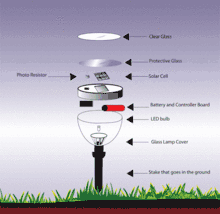
Solar panels
Solar panels are made out of crystals that are made out of covalent bonds between electrons on the outer shell of silicon atoms. Silicon is a semiconductor which is neither metals that conducts electricity nor insulators that do not conduct electricity. Semiconductors normally do not conduct electricity but under certain circumstances they do in this example with exposition to light.[7]
A solar cell has two different layers of silicon. The lower layer has less electrons and hence has a slight positive charge due to the negative charge nature of electrons. In addition, the upper layer has more electrons and has slightly negative charge. A potential barrier is created between these two layers.
When the stream of light particles called photons enter, they give up their energy to the atoms in the silicon. It promotes one electron from a covalent bond to a next energy level from upper layer to the lower layer.[2] This promotion of an electron allows freer movement within the crystal which produces a current. More light shines through, more electrons move around hence more current flows between. This process is called photovoltaic and photoelectric effect.[7] Photovoltaic systems literally means combination of light and voltage and they use photovoltaic cells to directly convert sunlight into electricity.[8]
Solar panels are made out of layers of different materials, as you can see in Figure 2, in order of glass, encapsulate, crystalline cells, encapsulate, back sheet, junction box and lastly frame. The encapsulate keeps out moisture and contaminants which could cause problems.[9]
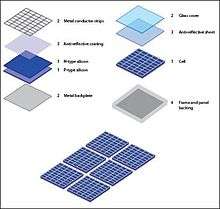
Battery
A battery is usually housed within a metal or plastic case. Inside the case are electrodes including cathodes and anodes where chemical reactions occur. A separator also exists between cathode and anode which stops the electrodes reacting together at the same time as allowing electrical charge to flow freely between the two. Lastly, the collector conducts a charge from the battery to outside.[11]
Batteries inside solar lamps usually use gel electrolyte technology with high performance in deep discharging, in order to enable use in extreme ranges of temperature.[12] It may also use lead-acid, nickel metal hydride, nickel cadmium, or lithium.
This part of the lamp saves up energy from the solar panel and provides power when needed at night when there is no light energy available.
In general, the efficiency of photovoltaic energy conversion is limited for physical reasons. Around 24% of solar radiation of a long wavelength is not absorbed. 33% is heat lost to surroundings, and further losses are of approximately 15-20%. Only 23% is absorbed which means a battery is a crucial part of solar lamp.[13]
Charge controller
This section controls the entire working systems to protect battery charge. It ensures, under any circumstances including extreme weather conditions with large temperature difference, the battery does not overcharge or over discharge and damage the battery even further.[14]
This section also includes additional parts such as light controller, time controller, sound, temperature compensation, lighting protection, reverse polarity protection and AC transfer switches which ensure sensitive back-up loads work normally when outage occurs.[12]
Working principles
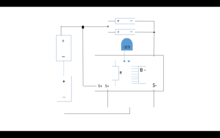
LED lights are used due to their high luminous efficiency and long life. Under the control of a DC charge controller, non-contact control automatically turns on the light at dark and switches off at daytime. It sometimes also combines with time controllers to set curtain time for it to automatically switch light on and off.[14]
As shown in Figure 3, the chip includes microchip(R), B-, B+, S- and S+. S+ and S- are both connected to solar panels with wire, one of which has plus charge and the other minus charge. B- and B+ are attached to two batteries in this case. The light will be shown through the LED light when all of these are connected.
Benefits
Solar lamps can be easier for customers to install and maintain as they do not require an electricity cable. Solar lamps can benefit owners with reduced maintenance cost and costs of electricity bills. Solar lamps can also be used in areas where there is no electrical grid or remote areas that lack a reliable electricity supply.[16] There are many stories of people with lung disease, eye deterioration, burns and sometimes even death simply because they do not have a healthy alternative to light at night. Women have felt unsafe walking to the toilet outside after dark. Babies are being delivered by midwives using only a candle, and students cannot study when the sun goes down for lack of light leading to increased illiteracy and perpetual poverty. These are the realities for over 1 billion people around the globe. Lack of lighting equates to continued poverty felt around the world.[17]
Solar energy output is limited by weather and can be less effective if it is cloudy, wet, or winter.[18]
Households switching to solar lamps from kerosene lamps also gain from health risk associated with kerosene emissions. Kerosene often has negative impacts on human lungs.[19]
The use of solar energy minimizes the creation pollution indoors, where kerosene have been linked to cases of health issues. However, photovoltaic panels are made out of silicon and other toxic metals including lead that can be difficult to dispose of.[20]
The use of solar lights improves education for students who live in households without electricity. When the nonprofit Unite-To-Light donated solar-lamps to schools a remote region of Kwa Zulu Natal in South Africa test scores and pass rates improved by over 30%. The light gives students added time to study after dark.[21]
A 2017 experimental study in unelectrified areas of northern Bangladesh found that the use of solar lanterns decreased total household expenditure, increased children’s home-study hours and increased school attendance. It did not however improve the children's educational achievement to any large extent.[22]
Use
Solar street light
These lights provide a convenient and cost-effective way to light streets at night without the need of AC electrical grids for pedestrians and drivers. They may have individual panels for each lamp of a system, or may have a large central solar panel and battery bank to power multiple lamps.
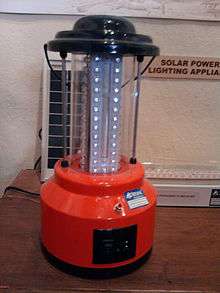
Rural
In rural India, solar lamps, commonly called solar lanterns, using either LEDs or CFLs, are being used to replace kerosene lamps. Especially in areas where electricity is otherwise difficult to access, solar lamps are very useful and it will also improve life in rural areas.[23]
See also
References
- ↑ "$10 solar-powered lamp to help the poor". Telegraph.co.uk. Retrieved 2015-12-16.
- 1 2 "How does solar power work?". www.scientificamerican.com. Retrieved 2015-10-31.
- ↑ "Champions of photovoltaics technology". www.renewableenergyworld.com. Retrieved 2015-10-31.
- ↑ "How do Photovoltaics Work? - NASA Science". science.nasa.gov. Retrieved 2015-10-31.
- ↑ Bergesen, Joseph D.; Tähkämö, Leena; Gibon, Thomas; Suh, Sangwon (2016). "Potential Long-Term Global Environmental Implications of Efficient Light-Source Technologies". Journal of Industrial Ecology. 20 (2): 263. doi:10.1111/jiec.12342.
- ↑ "Solar power use - Connect-Green". www.connect-green.com. Retrieved 2015-10-31.
- 1 2 "How do solar cells work? - Explain that Stuff". www.explainthatstuff.com. Retrieved 2015-10-31.
- ↑ "Photovoltaic Systems". Photovoltaic Systems. Retrieved 2015-10-31.
- ↑ Dow Corning (2009). "The Science of Solar: Solar Energy - The Basics" (PDF). Solar Solutions.
- ↑ "The Solar Panel". swcphysics30. Retrieved 2015-10-31.
- ↑ "How Batteries Work". HowStuffWorks. Retrieved 2015-10-31.
- 1 2 "Solar – Philips Lighting". www.lighting.philips.com. Retrieved 2015-10-31.
- ↑ Goetzberger, Adolf (1998). Crystalline silicon solar cells. Germany: John Wiley&Sons. p. 72. ISBN 0-471-97144-8.
- 1 2 "Solar Street Light,LED Street Light -- Anern Industry Group". www.anern.com. Retrieved 2015-10-31.
- ↑ https://www.youtube.com/watch?v=8earltsP35w, retrieved 2015-11-01 Missing or empty
|title=(help) - ↑ "Advantages and Disadvantages of Solar Energy | GreenMatch.co.uk". www.greenmatch.co.uk. Retrieved 2015-11-01.
- ↑ https://esperanzamarket.com/blogs/news/93744963-changemakers-spotlight-unite-to-light
- ↑ "Solar Power Advantages and Disadvantages". www.sepco-solarlighting.com. Retrieved 2015-11-01.
- ↑ "Solar-powered lamp and charger". British Museum. Retrieved 2015-11-01.
- ↑ "Disadvantages Of Solar Energy - Conserve Energy Future". Conserve-Energy-Future. Retrieved 2015-11-01.
- ↑ Unite To Light https://esperanzamarket.com/blogs/news/93744963-changemakers-spotlight-unite-to-light
- ↑ Kudo, Yuya; Shonchoy, Abu S.; Takahashi, Kazushi. "Can Solar Lanterns Improve Youth Academic Performance? Experimental Evidence from Bangladesh". The World Bank Economic Review. doi:10.1093/wber/lhw073.
- ↑ "nannammmaims-to-displace-kerosene-lamps.html Cheapest Solar Lantern Aims to Displace Kerosene Lamps". treehugger.com.
